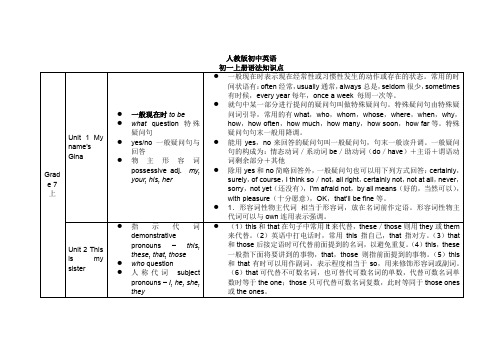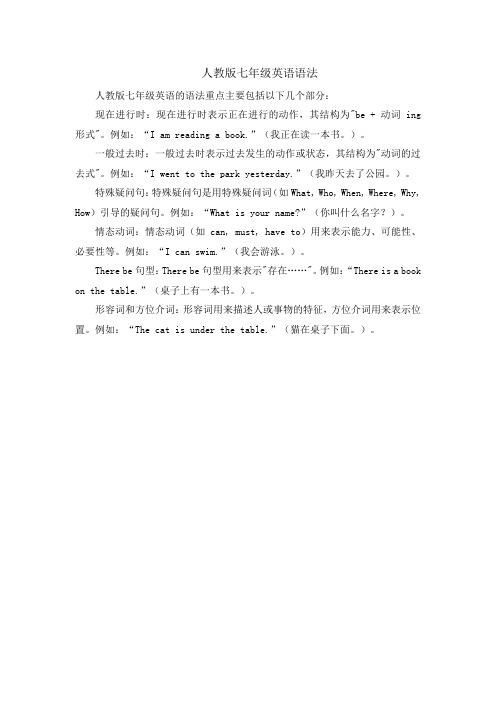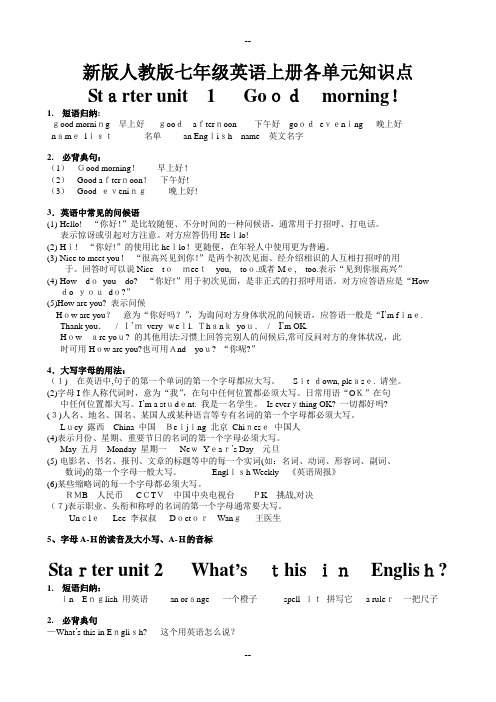人教版七年级英语上册语法点6——介词
初中语法大全讲解--介词

初中语法大全讲解--介词介词是一种用来表示名词与其他词语之间关系的词类。
介词通常用在句子中介绍时间、地点、方向、原因等概念。
以下是一些常用的介词及其用法解释:1. on:表示在某个表面或位置上on:表示在某个表面或位置上- I put the book on the table.(我把书放在桌子上。
)- The picture on the wall is beautiful.(墙上的画很漂亮。
)2. in:表示在某个范围内或位置内in:表示在某个范围内或位置内- She lives in a big city.(她住在一个大城市。
)- There is a pen in the pencil case.(铅笔盒里有一支钢笔。
)3. at:表示在某个具体的地点或时间点上at:表示在某个具体的地点或时间点上- We will meet at the park tomorrow.(我们将在明天在公园见面。
)- He is waiting for you at the front door.(他在门口等你。
)4. to:表示朝向某个目标或对象to:表示朝向某个目标或对象- She walked to school.(她走向学校。
)- Can you pass the book to me?(你能把书递给我吗?)5. with:表示伴随或使用某个工具或对象with:表示伴随或使用某个工具或对象- I went to the park with my friends.(我和我的朋友一起去了公园。
)- He wrote the letter with a pen.(他用钢笔写了这封信。
)6. by:表示通过某种方式或交通工具by:表示通过某种方式或交通工具- We usually go to school by bus.(我们通常坐公交车去学校。
)- She sent the gift by mail.(她通过邮寄发送了礼物。
(完整版)人教版七年级上册英语全册语法知识点梳理,推荐文档

第一讲:动词一.Be 动词(am, is, are)的用法口诀:I 用 am , you 用 are ,is 连着他(he)她(she)它(it)。
单数全部用 is,复数一律都用 are. 变疑问,往前提,句末问号莫丢弃,变否定,更容易,be 后 not 莫忘记,句首大写莫迟疑。
I a student. You Japanese.He my brother. She very nice.My name Harry. LiLei very tall.This book very interesting. Li Lei and I good friends.These apples. Those bananas.They students. There some bread on the plate.The cat black. The black pants for Su Yang.Here some sweaters for you. There a girl in the room.There some milk for me. There some apples on the tree.Gao Shan's shirt over there. Some tea in the glass.二.一般现在时态1.用法:(1).表示习惯性,经常性的动作,常与o f t e n,a l w a y s,u s u a ll y,e v e r y d a y/w ee k/m o n t h…等词连用I o f t e n p l a y s o cc e r.(2).表示主语具备的性格或能力:H e li k e s t o e a t b a n a n a s.2.在一般现在时态中,当主语是第三人称单数时,谓语动词也用第三人称单数, 第三人称单数的构成规则(主语不是第三人称单数时谓语动词用原形):a.一般情况下在动词词尾加 s 如:get----gets like----likes play—plays, want—wants,work—works,b.以字母 s、x、ch, sh,o 结尾的动词加-es:guess—guesses, fix—fixes, teach—teaches,brush—brushes, go—goes,c.以辅音字母+y 结尾的动词,先变y 为i,再加-es:study—studies,carry—carries,fly—flies,特殊词: have --- has一写出下列动词的三单形式。
人教版初中英语七年级上册语法知识点

have表示“有”时,其否定形式有两种:在其后直接加not,但常用于非正式用语中;利用助动词do加not。
②如果句子的谓语是实义动词,在谓语动词前加don't,doesn't,didn't。
③no,never,seldom,hardly,nobody,little,few,nothing等否定词也可以构成否定形式。
1.表示经常性或习惯性发生的动作2.表示现在存在的状态或情况3.表示正在发生的动作或存在的状态4.表示客观事实、真理和自然现象5.用于表示较固定的、按计划、规定将要发生的动作,但只限于begin,come,go,leave,arrive,stop,return,close,open,take,start,take,place等少数动作,6.用于if,unless,once,even if(即使)等引导的条件状语从句,when,before,until,as soon as,the moment(一……就)等引导的时间状语从句,no matter+wh-/-how-或wh-ever/however等引导的让步状语从句中,代替一般将来时
人教版初中英语
初一上册语法知识点
Grade 7
上
Unit 1 My name’s Gina
七年级上册Unit 6 人教版英语中考一轮复习(词汇+语法讲解)

一轮复习:七上U6 词汇+语法讲解【单词默写】【单词变性】healthy形容词变名词______________ really副词变形容词______________ well副词变形容词______________ week名词变形容词______________1. well ______________ _____________________ ___________________ ________________Well, let’s talk about it next time.Mary does well in English.I don't feel very well today.You can get water in the well.2. right ______________ _____________________ ___________________ ________________ ______________ Everyone has his own rights in the society.Yes, that’s right.All right, let’s go to the cinema.I’m sorry. That’s all right.I sit on the right of Mary while Mary sits on the left of me.3. then __________ ___________Till then, everything is too late.First, you put the meat into the pot. Then, mix it with water.4. question ________________ ________________I have many questions to ask my teacher.I was questioned by a policeman about the murder last night.5. want ________________ ________________I want to stay at home because of the rain.You are wanted to be a volunteer.The thief was wanted on the web.Do you want something to drink?【词汇用法】1. sure: adv./adj./be sure to do sth./be sure that…/make sure that…/make sure to do sth.2. so: adv./conj./so adj./adv. that/so that/so as to/not as adj./adv. so/I think so/I hope so.相关词辨析: because vs. sobecause: conj./因为/不与so连用so: conj./所以/不与because 连用3. habit: n./develop a habit of/break a habit of/good habits/bad habits近义词辨析: habit vs. custom vs. culturehabit: n./习惯custom: n./习俗culture: n./文化4. be: v./be+Adj./be+done/be+n./be+to do/be +doing/be +PP(prep. Phrase)5. eat: vt./eat sth./eat up近义词辨析: have vs. eathave: vt./have lunch(享用一餐)eat: vt./eat rice(享用具体的东西)【攻占语法】动词(二) 实义动词一、动词的分类: ____________ _____________ _____________ ______________二、动词的位置: 在句中充当_____________, 放在___________ 的前面或_____________的后面三、动词的用法:2. 实义动词1) 感官动词look/sound/taste/smell/feel +adj.2) 感观动词watch/see/hear/observe sb. do/doing sth.3) 使役动词make/let/have sb. do sth.get sb. to do sth.make sb./sth. donehave sth. donehave sth. doingget sb./sth. done4) 及物动词动词+名词5) 不及物动词动词单独使用动词+介词+名词请在及物动词的框内打”√”,不及物动词的框内打”×”□ask□buy □call□come □eat□excuse □find □finish □get□go□have□know□let□like□look□lose□meet□need□play□say□see□sell□sound□spell□take□thank□think□want□watch□help□love6) 双宾语动词动词+间接宾语+直接宾语动词+直接宾语+to/for +间接宾语请在是双宾语动词的框内打”√”□teach □learn □buy□sell□order □lend □borrow □dress□bring□take□send□give□tell□pay□hand□show□offer□read□pass□help□want【词汇练习】1.Amy usually eats an a ________ after lunch because it's her favorite fruit.2.Let’s think about some food for Henry’s b ________ party.3.For b ________ I have a glass of milk and some bread. They are healthy.4.Potatoes, c ________, and cabbages are vegetables my son likes best.5.We always have rice, chicken and salad for d________.6.I want to know something about David, the volleyball star's e________ habit.7.I have e________ for breakfast every day.8.Judy likes eating sweet food and doesn’t like doing sports. As a result, she becomes f ________ and unhealthier.9.Eggs, milk and strawberries are all healthy f________.10.I eat f ________ and vegetables every day, which are good for my health.11. A good study h ________ will help you learn English well.12.Tom ate a big breakfast. He had a h ________, an egg and milk.13.Do you want to be h _______? Then you need to eat well and do sports every day.14.All the students have l________ at school from Monday to Friday.15.I can’t answer this q ________. It’s too difficult.16.I like English very much. It's r________ easy.17.I need some vegetables, fruits and yogurt to make fruit s ________.18.He doesn’t want to be late for school again, s ________ he eats quickly and runs to school.19.For fruit, Jack likes apples and s________.20.—Can you come to my party?—That’s for s _______.21.I want a bowl of t ________ noodles, because I like vegetables very much.22.Eat more v ________ and less meat, then you will be healthier.23.We have five English classes a w________.24.It is w________ known that Hangzhou is a perfect city for sightseeing.25.Please come to our club, you are w ________ to join us!【参考答案】healthy形容词变名词health really副词变形容词real well副词变形容词good week名词变形容词weekly1. well 好吧擅长感觉舒服井Well, let’s talk about it next time.Mary does well in English.I don't feel very well today.You can get water in the well.2. right 权力对的好吧没关系右边Everyone has his own rights in the society.Yes, that’s right.All right, let’s go to the cinema.I’m sorry. That’s all right.I sit on the right of Mary while Mary sits on the left of me.3. then 那时然后Till then, everything is too late.First, you put the meat into the pot. Then, mix it with water.4. question 问题询问I have many questions to ask my teacher.I was questioned by a policeman about the murder last night.5. want 想应聘通缉想要I want to stay at home because of the rain.You are wanted to be a volunteer.The thief was wanted on the web.Do you want something to drink?一、动词的分类: be 动词情态动词助动词实义动词二、动词的位置: 在句中充当谓语,放在主语的前面或宾语的后面三、动词的用法:请在及物动词的框内打”√”,不及物动词的框内打”×”√ask√buy √call×come √eat√excuse √find √finish √get×go√have√know√let√like×look√lose√meet√need√play√say√see√sell×sound√spell√take√thank×think√want√watch√help√love6) 双宾语动词动词+间接宾语+直接宾语动词+直接宾语+to/for +间接宾语请在是双宾语动词的框内打”√”√teach □learn √buy √sell √order √lend□borrow□dress√bring□take√send√give√tell√pay√hand√show √offer √read√pass□help□want【词汇练习】apple birthday breakfast carrots dinner eating eggs fatter food fruits habit hamburger healthy lessons question really salad so strawberries sure tomato vegetables week well。
人教版七年级英语语法

人教版七年级英语语法
人教版七年级英语的语法重点主要包括以下几个部分:
现在进行时:现在进行时表示正在进行的动作,其结构为"be + 动词ing 形式"。
例如:“I am reading a book.”(我正在读一本书。
)。
一般过去时:一般过去时表示过去发生的动作或状态,其结构为"动词的过去式"。
例如:“I went to the park yesterday.”(我昨天去了公园。
)。
特殊疑问句:特殊疑问句是用特殊疑问词(如What, Who, When, Where, Why, How)引导的疑问句。
例如:“What is your name?”(你叫什么名字?)。
情态动词:情态动词(如can, must, have to)用来表示能力、可能性、必要性等。
例如:“I can swim.”(我会游泳。
)。
There be句型:There be句型用来表示"存在……"。
例如:“There is a book on the table.”(桌子上有一本书。
)。
形容词和方位介词:形容词用来描述人或事物的特征,方位介词用来表示位置。
例如:“The cat is under the table.”(猫在桌子下面。
)。
人教版七年级英语上册各单元知识点(详细)

新版人教版七年级英语上册各单元知识点Starter unit 1 Goodmorning!1.短语归纳:good morning 早上好goodafternoon下午好goodevening 晚上好namelist名单an English name 英文名字2.必背典句:(1)Good morning!早上好!(2)Good afternoon!下午好!(3)Good evening晚上好!3.英语中常见的问候语(1)Hello!“你好!”是比较随便、不分时间的一种问候语,通常用于打招呼、打电话。
表示惊讶或引起对方注意。
对方应答仍用Hello!(2)Hi!“你好!”的使用比hello!更随便,在年轻人中使用更为普遍。
(3)Nice to meet you!“很高兴见到你!”是两个初次见面、经介绍相识的人互相打招呼的用于。
回答时可以说Nice tomeetyou,too.或者Me,too.表示“见到你很高兴”(4)How doyou do?“你好!”用于初次见面,是非正式的打招呼用语。
对方应答语应是“Howdo youdo?”(5)How are you? 表示问候How are you?意为“你好吗?”,为询问对方身体状况的问候语,应答语一般是“I’m fine.Thank you./ I’mvery well. Thankyou./I’m OK.Howare you? 的其他用法:习惯上回答完别人的问候后,常可反问对方的身体状况,此时可用How are you?也可用And you? “你呢?”4.大写字母的用法:(1)在英语中,句子的第一个单词的第一个字母都应大写。
Sit down, please. 请坐。
(2)字母I作人称代词时,意为“我”,在句中任何位置都必须大写。
日常用语“OK”在句中任何位置都大写。
I’m a student. 我是一名学生。
Is everything OK? 一切都好吗?(3)人名、地名、国名、某国人或某种语言等专有名词的第一个字母都必须大写。
人教版英语七年级上册所有单元知识点总结
人教版英语七年级上册所有单元知识点总结3.This is a picture of my family.这是我们全家的照片。
4.In the first photo。
this is my father and this is my XXX.在第一张照片里,这是我的父亲,这是我的母亲。
5.This is my family tree.这是我们的家庭关系图。
6.What’s the name of your sister?你妹妹叫什么名字?重点语法1.名词所有格的使用2.人称代词的宾格形式:me。
you。
him。
her。
it。
us。
them3.指示代词this和these的用法Unit3 Is this your pencil?重点短语1.XXX用品2.in the pencil box在铅笔盒里3.a yellow ruler一个黄色的尺子4.on XXX在桌子上5.a blue pen一个蓝色的笔6.under XXX在椅子下面重点句型1.Is this your pencil?这是你的铅笔吗?2.Yes。
it is.是的,是我的。
3.No。
it isn’t.不,不是我的。
4.What’s this in English?这个用英语怎么说?5.It’XXX.这是一个铅笔盒。
6.Where is my pen?我的笔在哪里?7.It’s under the chair.在椅子下面。
重点语法1.名词的单数和复数形式2.物主代词的宾格形式:mine。
yours。
his。
hers。
its。
ours。
theirs3.介词in。
on。
under的用法Unit4 Where are you from?重点短语1.countries国家2.capital city首都nguages语言4.be from来自5.live in居住在6.a map of一张……的地图重点句型1.Where are you from?你来自哪里?2.I’m from Canada.我来自加拿大。
人教版七年级英语上册语法大全
人教版七年级英语上册语法大全一、名词(Nouns)名词是指人、物、地点、动物和概念等的名称。
名词可以分为可数名词和不可数名词。
1. 可数名词(Classifiable Nouns):可数名词可以用数字进行计数,并且可以有单数和复数形式。
如:book(书),apple(苹果),dog(狗),student(学生)等。
2. 不可数名词(Uncountable Nouns):不可数名词不可以用数字进行计数,只有单数形式。
如:water (水),music(音乐),money(钱)等。
二、冠词(ARTICLES)冠词是用于修饰名词的词语,在英语中主要有三种冠词:定冠词、不定冠词和零冠词。
1. 定冠词(The Definite Article):定冠词是指特指某个人或物的冠词,只有一个形式,即 "the"。
如:the book(这本书),the cat(这只猫)等。
2. 不定冠词(The Indefinite Article):不定冠词是指泛指人或物的冠词,有两个形式,即"a" 和"an"。
如:a book(一本书),an apple(一个苹果)等。
3. 零冠词(Zero Article):零冠词是指名词前没有任何冠词修饰的情况,也可以表示泛指。
如:I like flowers(我喜欢花)。
三、形容词(Adjectives)形容词是用来描述或修饰名词的词语,通常位于名词前面。
形容词可以分为具体形容词和抽象形容词。
1. 具体形容词(Concrete Adjectives):具体形容词用来描述或修饰可以通过感官观察得到的名词。
如:red (红色的),big(大的),beautiful(美丽的)等。
2. 抽象形容词(Abstract Adjectives):抽象形容词用来描述或修饰无法通过感官观察得到的名词,表示情感、状态或性质等。
如:happy(快乐的),difficult(困难的),interesting(有趣的)等。
人教版英语七年级上册Unit6知识点总结
精品基础教育教学资料,仅供参考,需要可下载使用!Unit 6 Do you like bananas?.知识点梳理Section A课文要点全解1.Tomatoes 西红柿Tomato 可数名词,意为“西红柿”,tomatoes 是tomato 的复数形式。
There are three tomatoes on the table.桌子上有三个西红柿。
助记:以o结尾需加-es构成复数形式的名词英雄(hero)爱吃西红柿(tomato)和土豆(potato),真有意思(es)。
典例精讲-How many________are there?-About fifty.A.tomatosB. tomatoesC. tomato解析:我们可采用“语法分析法”解答本题。
句意:”有多少个西红柿?”“大约五十个。
”how many 后接复数名词,tomato是以o结尾且表示有生命的事物的名词,变复数时在词尾加-es。
答案:B。
2.Salad 沙拉Salad 名词,意为“沙拉”,它是音译而来的。
Salad 是西餐中一道经典的凉拌菜。
传统的沙拉是将洗净、切成块状或片状的生蔬菜(通常包括主菜、黄瓜和西红柿等)与沙拉酱混合,均匀搅拌即可。
沙拉也有水果沙拉(fruit salad)、土豆沙拉(potato salad)、海鲜沙拉(seafood salad)等多个品种。
Do you like fruit salad? 你喜欢水果沙拉吗?I like potato salad. 我喜欢土豆沙拉。
[拓展] 谐音记忆各种“外来食品”:[英] hamburger--音译--[汉]汉堡包[英] salad--音译--[汉] 沙拉[英] sandwich--音译--[汉] 三明治k 牛奶Milk 不可数名词,意为“牛奶”。
My father doesn’t like milk,我父亲不喜欢牛奶。
[拓展] milk 作动词,意为“挤(牛、养等的)奶”。
人教版英语七年级上册常用方位介词和短语
【概念引入】本单元学习介词+定冠词the+名词构成介词短语的用法,介词后面可以跟名词和代词做宾语,构成介词短语。
今天我们主要学习一下用来表示方位的介词和介词短语。
【用法讲解】1. on介词on表示“在某物之上”的意思,它通常表示一个物体在另一个物体之表面上面。
两者之间有接触。
例如:Your book is on the desk. 你的书在课桌上面。
There is a ball on the floor. 地板上有个球。
拓展:above 和over的区别on指的有接触面的上面,但是over和above都是没有接触面的上面。
over“在……正上方”,与under相对。
例如:There is a bridge over the river. 河上有一座桥。
The picture is hanging over the blackboard. 那张图挂在黑板的正上方。
above只表示“在……上方或位置高出……”,不一定是正上方,与below相对。
例如:A plane flew above our heads. 一架飞机从我们头上飞过。
The Turners live above us. 特纳一家人住在我们的上面。
2. in介词in表示“在某物的里面”,它通常表示一个物体在另外一个物体的内部、中间或者在某个范围之内。
例如:Your pen is in the pencil case. 你的钢笔在铅笔盒里面。
She is the tallest in her class. 她是她们班最高的。
3. under介词under表示“在某物的下面”,它通常表示一个物体在另外一个物体的垂直正下面,两者之间没有接触。
例如:My bike is under the tree. 我的自行车在树的下面。
The shoes are under the chair. 鞋在椅子的下面。
拓展:under和below 的区别under表示“在……之下”,通常表示位置处于正下方,与介词over“在……上方”相对应。
- 1、下载文档前请自行甄别文档内容的完整性,平台不提供额外的编辑、内容补充、找答案等附加服务。
- 2、"仅部分预览"的文档,不可在线预览部分如存在完整性等问题,可反馈申请退款(可完整预览的文档不适用该条件!)。
- 3、如文档侵犯您的权益,请联系客服反馈,我们会尽快为您处理(人工客服工作时间:9:00-18:30)。
七年级英语上册语法点6——介词
1.in; on; at用在时间词前,表“在”
1)at + 具体时刻
2)on + 具体某天(具体某天的上、下午等;星期词;以及上、下午词前有修饰词时)
3)in + 年、月、季节及一天中的某部分
但注意:at night= in the night at noon
at this / that time at Christmas
eg. 1.___ the morning 2.___ Monday morning
3. ___ a rainy evening
4. ___3:50
5.__ 2002
6.___ the morning of April 10
7.___ spring
8.___ night 9.___ this time 10. ___ March
另外注意:在时间词(morning , afternoon , evening ; Sunday…)前有last, next , this , that时,不再用介词. tomorrow, tonight前也不用介词。
eg. I will go(A) to the cinema(B) in(C) this evening.
2. in , on , at 表地点:
at一般指小地方;in一般指大地方或某个范围之内;on往往表示“在某个物体的表面”。
例如:
eg. 1)He arrived ___Shanghai yesterday.
2)They arrived ___a small village before dark.
3)There is a big hole ____ the wall.
4)The teacher put up a picture ____ the wall.
3.in , on , to表方位
in(范围内);on(范围外且接壤);to(范围外但不接壤)。
可表示为下图的位置关系
eg.1)Taiwan is in the southeast of China.
2)Hubei is on the north of Hunan.
3)Japan is to the east of China.
cross: 动词“跨过,越过”=go across
4. across: (表面)跨过
through: (内部)穿过,贯穿介词
eg. 1)Can you swim _____ the river?
2)The road runs __________ the forest.
3) _____ the bridge, you’ll find a cinema.
5. in + 时间段:与将来时连用
after + 时间段:与过去时连用
但after + 时间点:可与将来时连用。
1) I’ll leave _______ three o’clock.. That is, I’ll leave ________ about ten minutes.
2)They left _______ two weeks.
6. in the tree(外加在树上的事物)
on the tree(树上自身具有的花、果、叶等)
in the wall(镶嵌在墙内部的事物)
7. on the wall(墙表面的事物)
1) There is a map ___ the wall
2) There are four windows ___ the wall.
8.by bike / bus / car / ship (单数且无冠词)
但当这些交通工具名词前有其它修饰词时,则应使用相应的介词。
eg. by bike = on a(the; his) bike
by car = in a(the ; her) car
on: 在…(表面)上——接触
9. over: 在…的正上方
above: 在…的斜上方未接触
1) The moon rose ______ the hill.
2) There is a bridge _____ the river.
3) There is a book ______ the desk.
10. between: 在(两者)之间
among :在(三者以上)之间
1)A big crowd of people were waiting for Li Lida on the beach. ________ them were his parents.
2)Tom sits ________Lucy and Lily.
11.on与about : 关于
on用于较正式的演讲、学术、书籍等
about用于非正式的谈话或随便提及
eg. He gave a talk ____ the history of the Party
12. in front of :在…前面/方(范围外)= before
in / at the front of:在……前部(范围内)
1)There is a big tree _______ of the classroom.
2)A driver drives _________ of the bus.
类似区别:at the back of与behind
13.with和in: 表示“用“
with: 指“用工具、手、口等”
in: 指“用语言、话语、声音等”
1) Please write the letter ____ a pen.
2) Please speak ____ a loud voice.
14. on a farm ; in a factory ; the girl in the hat ; leave for: 动身前往某地
15.一些固定搭配:
(1)介词与动词的搭配
listen to , laugh at, get to, look for;
wait for, hear from, turn on, turn off, worry about, think of, look after, spend…on…, 等。
(2)介词与名词的搭配
on time, in time, by bus, on foot,
with pleasure, on one’s way to, in trouble,
at breakfast, at the end of, in the end等。
(3)介词与形容词的搭配
be late for, be afraid of, be good at,
be interested in, be angry with,
be full of, be sorry for等。
二、常见方位介词短语
(一)、由介词in构成的方位介词短语
1、in the front 在前面
2、in the front row 在前排
3、in the back row 在后排
4、in the third row 在第三排
5、in front of... 在...前面(范围之外)
6、in the front of... 在...前部(范围之内)
7、in the middle在中间
8、in the street在街上
9、in the middle of...在中间10、in the tree在树上(指飞鸟等外来物)
(二)、由介词at构成的方位介词短语
1、at the front of...在...所在范围的前一部分
2、at the back of...在...所在范围的后一部分
3、at the foot of...在...脚下
4、at the top of...在...顶部
5、at the end of...在...尽头
6、at the head of...在...前头
7、at the(school)gate在(校)门口8、at the station 在车站
9、at No.2 Chang’an Road在长安路2号10、at my uncle’s 在我叔叔家11、at home在家12、at the doctor’s在医务室/在诊所
(三)、由介词on构成的方位介词短语
1、on the right/left在右(左)边
2、on one’s right/left在某人的右(左)边
3、on the desk/table在课桌/桌上
4、on the right-hand/left-hand side 在右/左手边
5、on the blackboard在黑板上
6、on/in the wall在墙上/里
7、on the paper在纸上8、on the tree在树上(指树上长的,结的东西)
三、其它介词构成的方位介词短语
1、next to靠近/贴近
2、beside the desk在课桌旁
3、behind the door在门后
4、under the bed在床下
5、near the window靠近窗户
6、outside the gate在门外。
